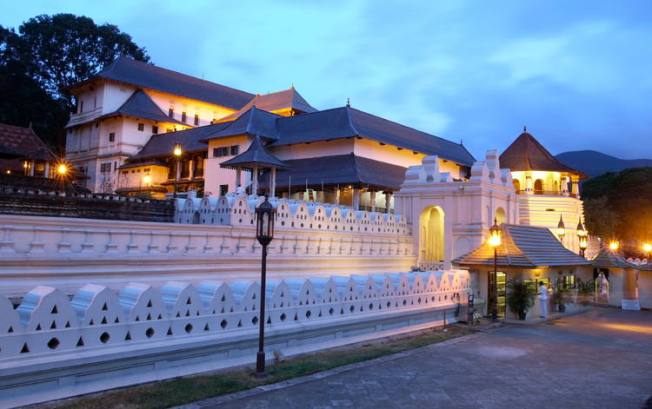Kandy city remains a bastion of Sinhalese culture and religion, home to the island’s most revered Buddhist temple and its most sacred relic in the Temple of the Tooth.
The best way to reach this beautiful city tucked in the central hills of the island is by railway. The early morning train from Fort, Colombo reaches Kandy before 9 am. This incidentally was the first rail route done by the British. It was done in 1864 to transport loads of coffee from the plantations in the hill country.
Just 3 kms away from the station and into the city is the sprawling temple complex overlooking the Kandy lake. During the month of April and May the rain-trees along the Kandy lake are in full bloom. Around the lake is a distinct and unique low white stone wall patterned in the shape of clouds with triangular carvings giving it a filigree effect.
The main entrance to the 17th century Temple of the Tooth is through an ornate archway and across a semi-circular moonstone. Surrounding the front entrance of the temple is a moat and the same low white cloud wall found around the lake.
Buddhist from all parts of the country arrive to pay homage and respect. Young parents are seen cradling their tiny babies whom they have brought to receive blessings. They stand in long queues to make offerings of thanks in hushed tones at the inner chamber. As you reach the main hall taking a series of elaborate archways adorned with frescos of Buddhist tales, an unmistakable calmness settles in. The entire gallery is done in wood. Wooden pillars inlaid with ivory and intricate carvings hold elaborate roofing. The floors seem to be well-polished by the feet of a thousand visitors. Occasionally the whole place reverberates with the sounds of virtuoso drummers and ringing of bells. The staircases at the end of the hall leads downward to the drummer’s courtyard and the Reception hall.
Apart from the two-storied building that holds the sacred tooth of the Buddha, there is the octagonal shaped Paththiruppuwa or viewing balcony used by royalty to address crowds of people, the royal palaces, and small shrines at the four corners for the veneration of Hindu deities protecting the temple.
The tooth relic is said to be encased in a jeweled casket and kept in an inner shrine on the second floor. The relic is removed only once a year during the Esala Perahera in the months of July-August. This ten-day ritual procession with elaborately dressed elephants, dignitaries, torch bearers, whip-cracking porters, drummers and dancers is perhaps the biggest festival in the whole of Asia. Throngs of pilgrims and tourists gather around the temple complex and long the lake en-route to witness the colourful pageant.
During the ancient times, the relic played an important role in local politics because it is believed that whoever holds the relic holds the governance of the country. While other areas were falling into the hands of foreign invaders the Kingdom of Kandy stubbornly held through till 1815, until that too fell into the hands of the British. Kandy the last capital of Sri Lankan kings was declared a World Heritage Site in 1988 mainly due the high importance given to the Temple.

